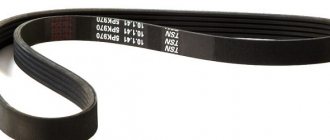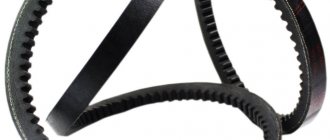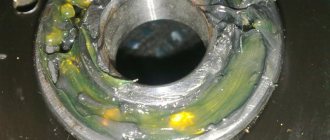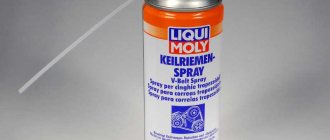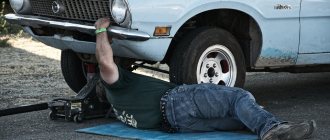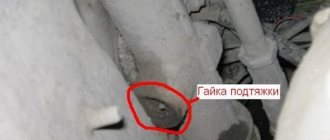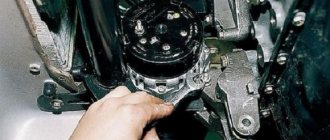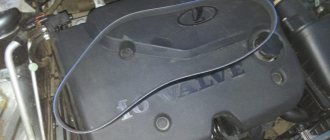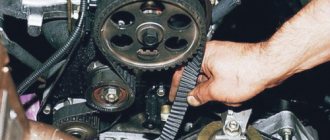The appearance of extraneous sounds after starting a cold engine, as well as during further operation of a warm engine, requires immediate clarification of the reasons. In the engine compartment you may hear engine knocking, whistling of belts and bearings of attachments, crackling or crunching noises, as well as other noises. Such sounds are superimposed on the overall smooth noise of the power unit, differing in strength, frequency and intensity.
We also recommend reading the article about what can knock in the engine. From this article you will learn how to determine the malfunction of various internal combustion engine components by the nature of the knock.
Whistling noise in a V-belt drive is usually caused by friction. A whistling sound appears due to the loss of one or two contacting surfaces of their properties. We add that belts, bearings and pulleys are influenced by the humidity of the outside air, temperature, degree of wear and damage, the amount of lubricant in the bearings, the quality of the belt drive adjustment and other factors. Next we will talk about what can most often make a whistle under the hood when starting the engine.
Why is there a whistling sound when cold?
There are four main reasons why a whistle occurs during a cold start. Let's look at them in order from the most common to the "exotic".
Alternator belt problem
The most common reason that a whistle is heard when starting the engine when cold is that the alternator belt in the car engine is slipping. In turn, this may be caused by one of the following reasons:
How to eliminate a whistling alternator belt
Why does the alternator belt whistle and how to deal with it. 5 main reasons for a whistling belt (alternator belt, power steering belt, water pump, air conditioning compressor). Causes of belt whistling and tips for eliminating it. More details
Similar reasoning is valid for other belts used in the car. In particular, the air conditioning belt and the power steering belt. If left idle for a long time at a cold temperature, they can become stiff and make whistling sounds until they warm up as a result of their work. Similarly, they can whistle due to weak tension and/or due to severe wear.
In rare cases, frost can cause the grease in the generator shaft bearing to thicken significantly. In this case, immediately after starting, the belt may slip, since the engine needs to apply more force to unwind the generator shaft. Usually, after the lubricant acquires a more liquid consistency, the belt slippage, and therefore the whistling sounds, disappear.
Also, in rare cases, the belt may whistle and slip due to the fact that moisture condenses on its inner surface (adjacent to the drive pulleys). For example, when the car is parked for a long time in conditions of very high humidity (at a car wash, in a hot sea climate). In this case, after starting the engine, the moisture will naturally evaporate and the whistle will disappear.
Like moisture, various process fluids can get onto the belt. For example, motor oil, antifreeze, brake fluid. In this case, the duration of the whistle will depend on how much liquid gets on the belt and how quickly it is removed from its surface. In this case, in addition to assessing the condition of the belt and its tension, it is necessary to diagnose why this or that process fluid gets on the belt. And carry out the appropriate repair measures. They will depend on the reason.
Worn tension roller
In cars equipped with a tension roller, this can be the source of the whistling “when cold”. In particular, the roller bearing, which gradually fails. It may also whistle at certain engine speeds. Diagnostics of the roller must begin with checking the tension. Often, the roller begins to whistle when the drive belt or timing belt is under- or, conversely, over-tensioned. Please note that over-tightening a belt is harmful to the bearings of the individual rollers and pulleys that said belt connects.
You also need to assess his general condition. To do this, you need to remove the roller from its seat. Next, you need to inspect its wear and ease of rotation of the bearing. Be sure to check the roller (bearing) for play, and in different planes. Along with the roller diagnostics, you also need to check the condition of the belts.
Water pump failure
The pump, or another name for the water pump, can also make a whistling noise when starting the engine when cold. On some older cars, the pump is driven by an additional belt from the crankshaft pulley. In modern cars, it is rotated by the timing belt. Therefore, often on older cars, the pump drive belt can also stretch and slip over time. An additional source of unpleasant sounds can be a worn pump pulley. The belt will slip over it and whistle.
Often, when the belt heats up, the whistling disappears, because if the belt is not stretched too much, it stops slipping and, accordingly, the whistling sounds will go away as the power unit warms up.
Similarly, as with a generator, the water pump’s bearing grease may thicken, or even be completely washed out of its working cavity by antifreeze. In this case, there will be a slight whistle when starting the engine when cold. However, if there is no lubrication at all, then often whistling sounds will be heard not only when it is cold, but also while the car is moving on the road.
In addition to these obvious and explainable reasons for whistling under the hood when cold, there may also be some that are completely unrelated to the operation of the belt and rotating mechanisms. So, for example, when warming up the engine on VAZ cars (in particular, Lada Granta), there may be such a rare case as resonance of the crankshaft position sensor. So, the sensor (abbreviated DPKV) produces a high-frequency squeaking sound between its internal parts, as well as the engine housing. This is due to the design feature of the sensor.
Symptoms of malfunction and their elimination
You can determine whether a replacement is needed or whether you can simply tighten the power steering belt with air conditioning on the Priora 16 valves only after inspecting this component.
To do this, just open the hood and examine the belt; it is located next to the right front wheel. There are signs that indicate it's time to check the alternator belt: something whistling and squeaking from under the hood. The reasons may be the following:
- Antifreeze, oil or other working fluids have come into contact with the generator pulley or belt.
- The belt is worn out - you can tell by its appearance.
- The tension has dropped - in this case, the component must be tightened.
- The bearing in the generator is worn out.
When the belt whistles in a Priora with 16 valves, it’s time to carry out diagnostics. If there are cracks, tears or other serious damage on its surface, then replacement is required. If the generator component with hydraulic booster and air conditioning looks normal, you should check its tension; the optimal level of deflection is 6-8 mm - you need to press the component in the middle between the generator and the pulleys.
Are there visible coolant or engine oil stains on the surface? If the contamination is not significant, they can be cleaned. If the liquid has penetrated into the material, cleaning will not bring any results; replacement is needed. If the component is well tensioned and no damage or stains are visible, then you should move on to checking the bearings. They may need to be changed.
How to eliminate a whistling sound when starting the engine
Elimination methods will depend on the immediate cause of the whistle when starting on a cold engine. This may be necessary:
Since, according to statistics, the alternator belt is most often “to blame,” the diagnostics need to start with it. It is recommended to perform the appropriate check every 15.20 thousand kilometers or more often. Typically, a V-belt is used for a generator. When checking, you need to pay attention to the presence of cracks on its inner surface (ribs) when the belt bends. If cracks occur, the belt needs to be changed. The approximate recommended mileage of a car to replace the alternator belt is about 40...50 thousand kilometers. Please note that the life of a particular belt is also affected by its tension.
If the belt tension is loose, it must be tightened. This is usually done using a corresponding roller or adjusting bolt (depending on the design of the particular car and its engine). If a tension mechanism is not provided, then in this case it is necessary to replace the stretched belt with a new one.
Fixes
What to do if you hear a squeaking sound from the generator belt? You shouldn't change it right away. Sometimes there is a whistle, but the resource of the consumable has not yet been exhausted and it can be further used. Therefore, if extraneous sounds occur, you should inspect the belt drive and find out where the squeak comes from. To diagnose, open the hood and inspect the strap for:
- integrity of the part;
- degree of wear;
- presence of traces of working fluids on the surface;
- displacement of the pulley line, they must be strictly on the same line;
- degree of tension of the product.
Replacement should be done if the surface is worn out, there are cracks, assemblies, or frayed edges. If traces of oil, coolant or other contaminants are found, you can try cleaning the surface. Contamination prevents the product from stretching and moving evenly. If they cannot be removed, the consumable must be replaced.
The cause of generator transmission may be wear of the bearing in the tension roller or generator. To diagnose the serviceability of the tension roller, you need to dismantle it and check for defects and play. If any malfunctions are found, parts must be replaced.
The following factors influence the service life of components:
- terms of Use;
- driver's driving style;
- degree of load;
- product quality;
- correct installation.
The most common cause of whistling is poor belt tension. To check it, you need to press the product between the generator and crankshaft pulleys somewhere near the middle.
The deflection should be in the range from 6 to 8 mm. If the tension is not correct, it needs to be adjusted. If the tension is poor, the unit does not produce a full charge. To tension you need to do the following:
After the tension adjustment procedure, you need to check the operation of the unit. Before starting the engine, you need to turn on several devices powered by the generator, for example, a heater, air conditioning, and high beams. If everything is in order, then there is no whistle and the charging level is at the proper level.
To improve the operation of the belt drive, you can lubricate both surfaces of the rubber product with special liquids, for example, Hi-Gear and VeryLube conditioners. With their help you can also get rid of squeaking, but they give temporary results. Regular use of conditioners extends the service life of belts by 1.5-2 times.
The whistling of the alternator belt when the engine is cold is a common occurrence when operating cars even with low mileage.
Why it occurs, how dangerous it is, how to eliminate it without replacing the belt and tensioner itself, how to lubricate it so that it doesn’t whistle, we’ll look into this article.
Grinding, knocking or whistling noise when starting the engine
The appearance of extraneous sounds in the engine compartment during or immediately after starting the engine is a reason to diagnose and check the internal combustion engine. Various deviations from the norm can occur as a result of wear of individual elements of attachments, drives, bearings, pulleys or belts. Also, one should not exclude the possibility of breakdown of the power unit itself and its components. Drivers often notice that when starting the engine when cold, a grinding noise is heard, something creaks in the engine, a whistle appears, etc.
It should be noted that usually many sounds are better heard during a cold start, although in some cases the noise does not go away even after the power unit warms up. It should also be added that in some cases the problem progresses noticeably, that is, the sound gets stronger each time or gradually. In other situations, extraneous noise may not change its tone and intensity over hundreds or even thousands of kilometers.
In this article we will talk about what kind of breakdowns can lead to noise being heard during a cold engine start, as well as how and by what additional signs you can determine the malfunction yourself.
Belts
Second on the list of suspects were the timing belts and attachments, as well as the drive bearings of these equipment. Bearings do not last forever, and when they wear out, they often begin to make abnormal sounds. The belts lose their tension and begin to slip, which is why they also begin to “sing.” We opened the hood, listened to the engine running at idle, and found no extra noise. The whistle and jammed gas pedal did not turn on, so the car owner was asked to drive the car to a decent car service center. Professional mechanics assessed the current state of the drives, but this examination did not add clarity to the situation. Everything, from the point of view of specialists, is normal, all engine systems are functioning as expected.
A grinding noise is heard when starting the engine
If the driver turns the ignition key to the “start” position and at this moment a grinding noise is heard, and the noise disappears after the engine “cages” and starts working on its own, then the most common cause is considered to be a faulty starter.
If, when starting the engine, you hear the starter grinding whether it is cold or hot, then there may be several reasons for such a malfunction.
As a rule, it is necessary to check the solenoid relay, starter bendix and flywheel. The fact is that the bendix may not engage with the flywheel properly, resulting in a crackling sound or a characteristic starter grinding sound when starting the engine.
Recommendations
There are many possible abnormal noises during cold engine starting. When they are detected, it is important to have the vehicle checked as soon as possible, as these noises could be hiding a serious problem, or it could be a harbinger of a future serious problem.
To eliminate any type of noise when starting a car when cold, it is highly recommended to contact a workshop. Answer 2 important questions: “what noise?” and “where does it come from?” This information will help technicians diagnose the problem.
Some of these noises are caused by worn or broken parts, plastic or metal. In many cases, it is not possible to replace the part (due to their high cost, lack of goods, etc.) and, to eliminate the malfunction, in such cases, it is recommended to use two-component glue.
Source
A whistling sound is heard when starting the engine
A whistling sound at start-up usually comes from the alternator belt or the cooling system water pump (pump). The malfunction manifests itself in the form of a high-frequency squeak or squeal after starting the internal combustion engine, and can also make itself felt already on a warm engine when you sharply press the gas pedal and increase the crankshaft speed.
To check the generator and/or pump, you can take a block of wood, you can also attach a tin can to the end of a wooden stick, etc. Then one end of the bar or stick is applied to the drive area of the generator or pump with the engine running, and the other end of the bar or a tin can attached to the stick is brought to the ear. This solution allows you to more accurately determine the source of noise and localize the fault. By the way, if possible, instead of a homemade device for listening to noise, you can use the so-called car stethoscope (sometimes a medical one is also used).
If the source of the noise is not fully identified, then it is necessary to remove the generator belt, after which the pump or generator pulley is sharply turned by hand. The appearance of noise, difficulty during rotation, beating, play and other deviations from the norm will indicate a problem. In the case of a generator, the device can be repaired by replacing the bearings. It is recommended to change the pump immediately, since on many cars a jammed water pump leads to a broken timing belt.
An additional reason to replace the pump is considered to be the appearance of antifreeze or antifreeze drips at the place of its installation. Coolant leaks pose a danger in the form of overheating of the internal combustion engine; a broken timing belt means that the piston hits the valves, causing the valves to bend. Ultimately, if these problems are ignored, the engine may require expensive or even major repairs.
Possible consequences and breakdowns
Knowing the causes of the whistle, it is easy to predict the consequences and malfunctions that may result from ignoring the problem:
- the tape may fly off the shafts;
- belt rupture;
- failure of the power steering and generator.
Whistle when accelerating. Causes of a whistling sound when you press the gas
Please note that you can drive with a torn or missing alternator belt, but not for long. The battery discharges several times faster due to the generator not working, the power steering turns off - turning the steering wheel becomes much harder
Therefore, if it is not possible to fix the malfunction yourself, we recommend not to take risks and immediately, after a breakdown occurs, go to the nearest car service center to install a new belt.
For the engine itself, a break or collapse of the generator belt is not a critical failure. Since its main function is to spin up the generator, stopping rotation can lead to the cessation of its operation. This will increase battery consumption. In addition, the air conditioning and power steering may stop working, because... the generator belt also transmits rotation to their pulleys.
There is a knocking sound when starting the engine
The appearance of knocking in the engine should be divided into problems with the gas distribution mechanism and the elements of the internal combustion engine itself (crankshaft and CPG, pistons, connecting rods, crankshaft, etc.). Extraneous sounds in the timing area may indicate significant wear of the rollers, defects in the timing belt or chain.
The rollers may whistle, howl, crunch or tap. In some cases, the timing belt rubs against the protective casing. We also note that on motors with a chain, when the chain itself is stretched or the tension is insufficient, the sound resembles a rustling chirping, and popping noises can also be heard. If you increase the speed, such sounds disappear and appear again after releasing the gas. In this situation, the timing chain needs to be tightened or replaced.
On engines with hydraulic compensators, a common cause is failure of the latter or clogging of the oil supply channel to the hydraulic compensator. In this case, the sound is clear, clear, and can be easily heard in the valve cover area. Note that on many cars, after a cold start, the hydraulic compensators knock for several seconds until the engine oil reaches them. This is considered the norm. If the knocking does not go away after the engine warms up, then you need to contact a service center or solve the problem yourself.
Now about knocking in the engine itself. After starting a cold unit, you can hear the pistons knocking in the cylinders. The knock is dull, similar to hitting pottery. The knocking of the pistons is most pronounced at idle, as well as at low speeds under load.
What else can knock, make noise or whistle in the engine after starting?
As you can see, there are quite a lot of reasons for the appearance of knocks and noises. It should be added that when starting a cold engine, especially in winter, increased noise and chirping can be produced by the injection nozzles themselves on units with a pressure fuel injection system.
In some cases, this does not indicate any malfunction, since after a slight warm-up the noise intensity decreases or the extraneous sound completely disappears. A knock can also occur at the moment of starting in the cold due to heavily hardened ICE cushions (the engine is conditionally driven when the starter rotates slightly forward, and after starting it “bounces” back).
You should also not forget about the air conditioning compressor, especially if the engine is started in parallel with the air conditioning turned on or the climate control is activated immediately after starting. The compressor drive or the compressor itself is often the cause of extraneous noise.
The appearance of unnecessary sounds can also be associated with faulty gearboxes or clutch elements. For example, a hum after starting the engine may well come from a release bearing. It should also be taken into account that on many cars the gearbox is located directly in the engine compartment near the internal combustion engine. If it is the transmission that is humming, then this noise needs to be differentiated separately, since the engine and attachments in this case do not require additional diagnostics.
Source
Application of the extractor
An extractor can be a solution to the problem. The tool is a kind of screwdriver, the tip of which contains a reverse thread. On the opposite side of the device there is a perpendicular crossbar with which you can perform rotations.
First, you need to make a notch on the head of the fastener using a punch and a hammer. The mark must be strictly in the center. Using a metal drill, make a small hole in the head.
Next, you need to use the extractor itself. The tip of the tool should be inserted into the prepared notch and hit on its back side with a hammer. It is necessary to tap the extractor until it is firmly fixed in the fastener head. Then you need to turn the device several times. Once the reverse thread of the extractor is firmly rooted in the structure of the material, you can begin to remove the screw.
